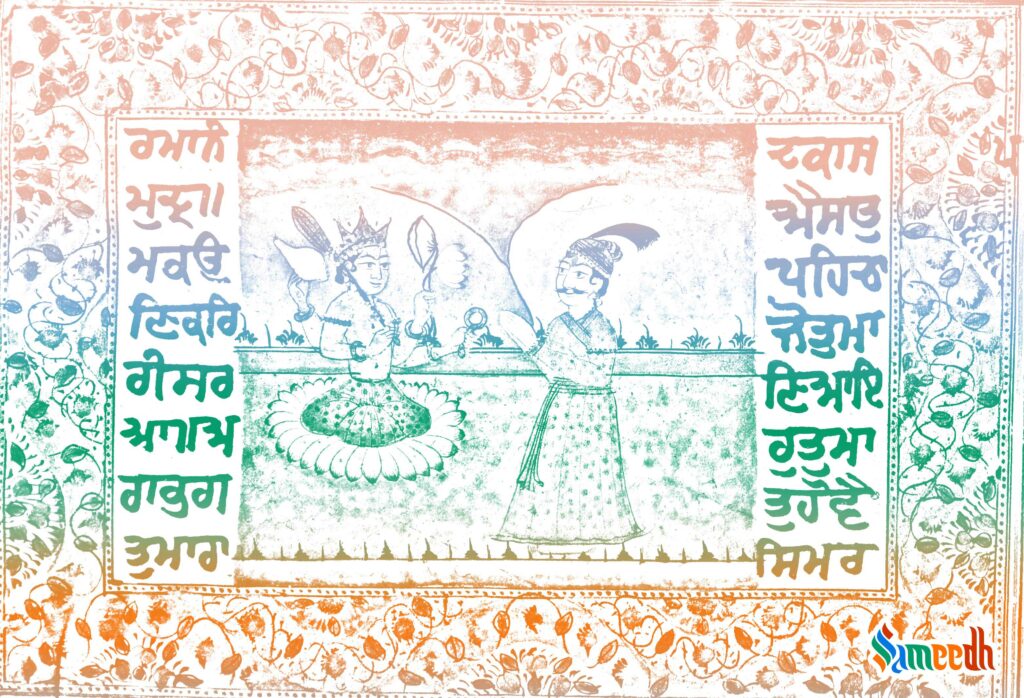All we know about King Parikshit is that he was the grandson of Arjuna. Just this one distinction is not enough to remember him for so long.

Raja Parikshit standing in front of Vishnu ; Image Source: Miniature Painting, Kashmir School – Google Cultural Institute
BACKGROUND
Parikshit was a Kuru king who reigned during the Middle Vedic period (12th-10th centuries BCE). Along with his son and successor, Janamejay, he played a decisive role in the consolidation of the Kuru state, the arrangement of Vedic hymns into collections, and the development of the orthodox srauta ritual, transforming the Kuru realm into the dominant political and cultural centre of northern Iron Age India. He also appears as a figure in later legends and traditions. According to the Mahabharat and the Puranas, he succeeded his grand uncle Yudhishthira to the throne of Hastinapur.
LIFE
Parikshit is believed to be a reincarnation of Satya Yuga, the personified first yuga in Hindu mythology. The Bhagavata Purana states that the son of Drona, Ashwatthama had prepared Brahmastra to kill the Pandav’s heir King Parikshit, while he was in his mother Uttara’s womb, as a revenge against the Pandavs for killing his relatives and friends (in particular his father Dron and friend Duryodhan) in the Kurukshetra war. Uttara was terrified by the powerful rays of the weapon. Her mother-in-law Subhadra prayed to Krishna, who was also her brother, for help to save their heir. Krishna protected the child in the womb from the deadly weapon and thus saved his life. Parikshit was thus born to Uttara. He was named Vishnurata because Lord Vishnu had given him to the Pandavs when their race was about to become extinct. Later he was crowned heir to the Pandavs at Hastinapur.
According to the Shatapatha Brahmana, Parikshit was the husband of Queen Madravati and they had four sons, Janamejay, Bhimsen, Ugrasen and Śrutasen. According to the Mahabharat, he ruled for 60 years.
His bodily existence ended due to the Nag king, Takshak, the ruler of Takshashila acting as the instrument of death. There are two incidents governing the death of Parikshit; the curse of the sage Shringi that he would die of snakebite within seven days for disrespecting his father by throwing a dead snake around his neck and, the vow by nag king Takshak to kill one of the lineages of the Pandavs after Arjun set fire to the Naglok after conquering Khandavprasth.
Parikshit was succeeded by his son Janamejay. On hearing of his father’s death by Takshak, Parikshit’s son Janamejay vowed to kill Takshak and starts the ‘Sarpasatra’, a yagna, which forced each and every snake of the entire universe to fall in the havan kund. Later, this yagna was stopped from doing so by Astik Muni, (son of Mansa Devi). Thus, Takshak was spared and Janamejay stops his ‘Sarpasatra’. That day was Shukla Paksha Panchami in the month of Shravan and since then is celebrated as the festival of ‘Nag Panchami’.
CONTRIBUTION IN SOCIETY
The bulk of the Rigveda Samhita was composed between circa 1500 and 1200 BCE. The other three Samhitas are considered to date from the time of the Kuru Kingdom, approximately c. 1200–900 BCE. King Parikshit (circa 1200-1100 BC or the late Rig-Vedic period) along with other kings of the kuru dynasty were primarily responsible for the collation of diverse strands of material into singular ‘national’ collections – Rig Veda Samhita, Samveda Samhitas and Khilani.
To know more about Hinduism, its Vedic belief system, prayers & devotional bhajans,hymns, mantras, or for any special need like conducting a pooja at your home please visit our website Sameedh.